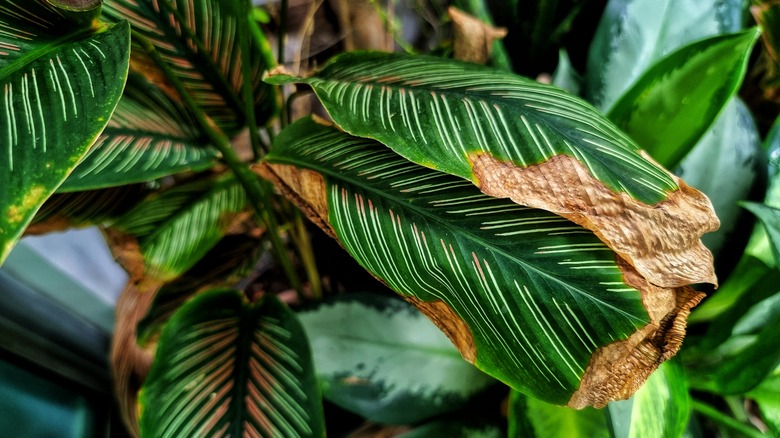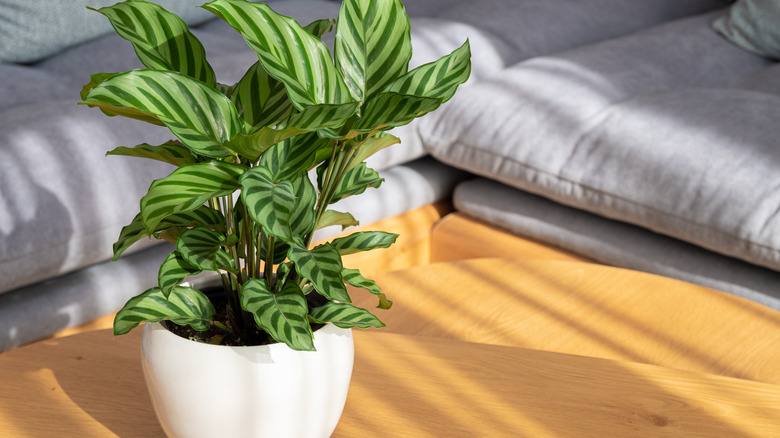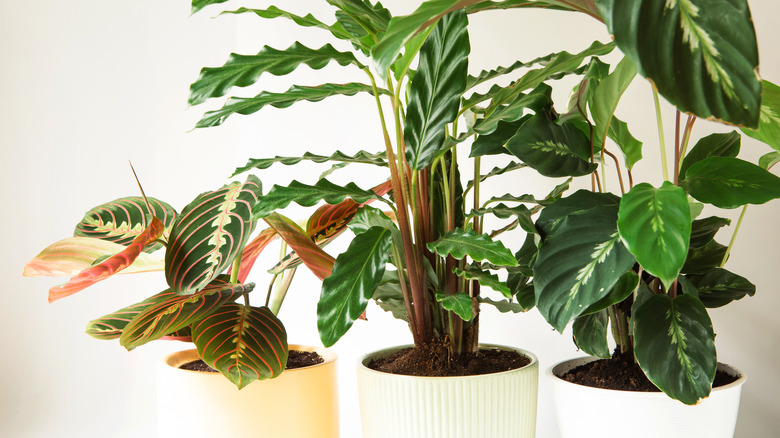How To Save Your Calathea Plant From Crispy Edges
Calatheas are a genus of plants that mostly hail from the tropics of Brazil. In their native habitat, they are cultivated for a variety of reasons such as food wrapping or basket weaving. Though, in the height of the tropical plant craze, they have transplanted into many chic living rooms as decor and may be struggling to adapt to their new surroundings. If you've noticed that your calathea plant has brown, crispy edges, you will certainly need to develop a new watering schedule and tend to your space's humidity. Calatheas rely on high humidity and well-draining, slightly moist soil in order to thrive.
To provide the best environment in your home for your tropical plants, there are a few instruments you may want to invest in. Hydrometers or moisture meters are inexpensive tools that allow you to measure the water content in potted plants. Add to the list a humidity meter to identify the water content in your air. Finally, you'll want to have at least a basic thermometer to ensure the temperature of the space is ideal for plant growth.
Water and sunlight care for calatheas
When tending to tropical plants like calatheas, a consistent watering schedule is the most important factor for survival. Tropical rainforests and jungles, where calatheas are native, have frequent rainstorms, providing them with reliable moisture. To replicate this habitat in your home and avoid those brown, crispy leaves, never let the soil dry out completely.
Use a moisture meter to determine the moisture level in the pot. If the top half of the soil in the pot is dry, give the plant a good soak, dumping out any overflow water from the tray beneath it. Most calatheas will need to be watered every one to two weeks depending on the amount of sun exposure and the season, with more frequent waterings in the summer or if the plant is near bright windows. Nailed the watering schedule but still have the brown tips on the leaves? It may be due to poor soil drainage, so consider repotting in well-draining, loamy soil instead.
Since calatheas typically grow on the floor of the rainforest or jungle, hidden by the canopy of much taller plants, they prefer bright, indirect light. Calatheas will thrive by east or south-facing windows, especially with a sheer curtain to filter the sun. A west-facing window will provide strong, afternoon light and can damage the sensitive leaves, causing burns or fading in the leaves. If you notice the calathea becoming leggy — tall with few leaves — consider moving it closer to a window for more light.
Proper humidity and temperature for calatheas
Second to watering, the humidity in a room is most impactful for a calathea's health. Calatheas prefer high humidity around 80% but can survive with as low as 60%. Anything lower than that will result in brown, crispy leaves. Use a humidity meter to test the ambient humidity in your room. If the humidity is on the dryer side, consider purchasing a small plant humidifier to add moisture to the air near your plants. While some may say that misting plants daily will increase the moisture, it actually rarely does. Instead, it encourages fungal and pest infections.
Should a humidifier not be in your budget, you can actually raise the humidity in the room for your plants by simply placing many of them near one another. Plants naturally release water into the air through a process called transpiration, contributing to a more humid environment. The more plants that are placed together, the more humid the space will become.
Tropical rainforests are quite warm, so your plant space needs to accommodate them. Aim for consistency between 65 and 85 degrees Fahrenheit for your calatheas. Too hot or too cold will produce those formidable brown, crispy leaves as well. Do beware of cold drafts if you open the windows in the fall or spring. Even a crisp wind can chill a plant and cause the leaves to die. A good rule of thumb is that if you're too hot or too cold, then your plant probably is too!


